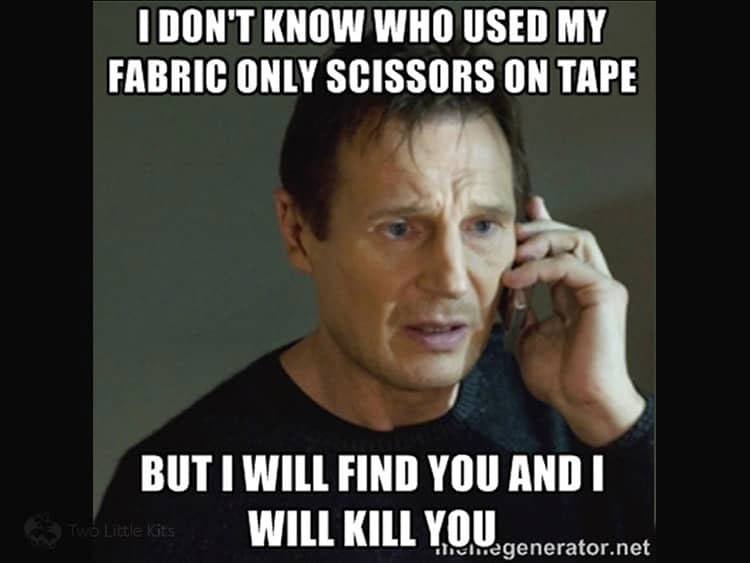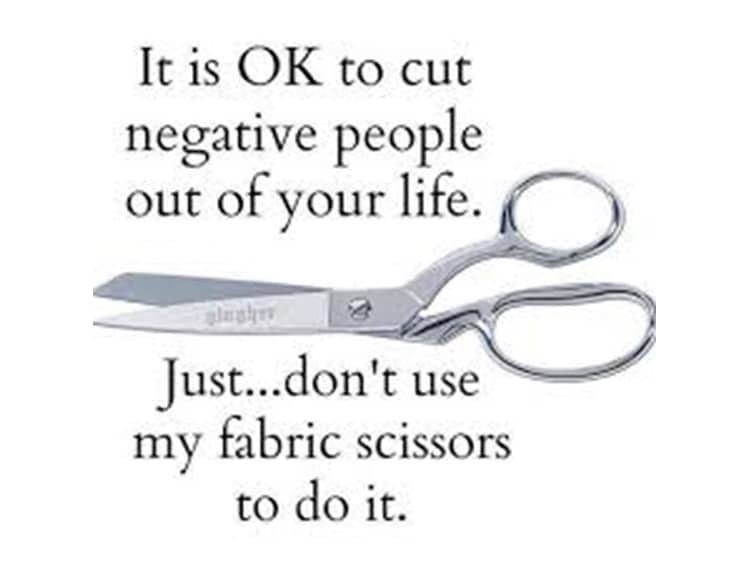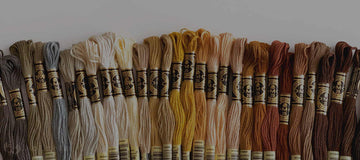A crafter's best friend
You've likely heard or seen memes online about not using your mother's or grandmother's crafting/fabric scissors. That these sacred tools are not to be trifled with, despite doing "just one cut" or something similar.
Is it all malarky? Is it that much of a crime to cut "just this one thing"? I'll let you be the judge of your tools but here's some information I've learnt over the past few years that I wanted to share!
👉 Jump straight to caring for your scissors.

Meme examples






What's the deal with fabric-only scissors?
Likely, that crafter in your life doesn't just have fabric scissors, either. They may have a whole arsenal of them. Why is that?
Well, a lot of scissors are used specifically for one purpose. Some may cut thread, some to cut the fabric of different weights and textures, some cut fusible interfacing, some cut wire, etc. And if you mix these into one pair of scissors then it's likely that pair won't cut properly for a future project where you need precision.
All of the following ways to take care of your scissors are not just for seamstresses. Those who craft with paper, fabrics, yarn or any mixed media; you will also want to take note on the best ways to keep your scissors -and you- happy.

Scissors examples and what they're for




How to care for your scissors
If you make sure to take care of your scissors (both from rusting and from being used in the wrong way!) a pair of them can last you years and years! So what is some good things to keep in mind?
-
Cut fabric only!
Yes; cutting things other than fabric can damage your scissors - that crafty person in your life isn't just being annoying or difficult. It can dull the blades, misalign them and just break them entirely.
-
If it has one; tighten the pivot screw and oil it periodically
Some scissors (like those huge, heavy, all-metal ones your granny probably has) need some TLC occasionally to make sure they're cutting like they are supposed to. So get a wrench or a screwdriver (whichever is needed), give it a squeeze and apply a drop of oil
-
Consider how you store them when not in use
Do you chuck them amongst pens or other tools? This can scratch and nick the blades, it can weaken the tips (especially those that are designed for sharp points!) and even knock them out of alignment.
The best thing to do is store them in a sheath (either one that it came with or make one up out of soft fabric or felt) or hang them by one of the handles.
-
Keep them nice and sharp
There is such a thing as a professional sharpener - someone who sharpens knives and scissors for a living. It might seem like overkill but when you consider how expensive some pairs of scissors are (upwards of $150 and more) and in some cases, that they are handed down
-
Keep them squeaky clean!
But not so that they squeak when you use them, of course!
But in all seriousness, using warm water and dish soap will suffice to keep your scissors free from any build-up, rust or residues. You can use other more heavy-duty things like paint thinner (for stickiness), acetone nail-polish remover (for dried glues) or white vinegar-soaked cotton balls (for rust removal) to keep them going strong.
Keeping them clean also includes wiping away any excess oil when you oil the pivot area. You want them looking schmick, too!
-
Check twice - cut once
This saying is usually reserved for making sure you don't cut the wrong amount, but it also fits into making sure you don't cut into things that might be lurking, such as pins, glue or materials that aren't designed to be sliced by certain types of scissors. Double-check what you are cutting beforehand.
-
Try not to drop them!
It might sound silly, but this can knock the blades out of alignment. It can also dent them and damage the tips. They could also land pointy-side on your foot! Ouch!
We all know accidents happen, but hopefully, the universe is kind to you ❤️
In conclusion
Taking care of your fabric scissors might seem like a lot of extra work, but it’s well worth the effort! By following these tips, you'll keep your scissors in top-notch condition, which means smoother, more precise cuts for years to come. After all, these tools are an investment, often carrying sentimental value and memories with them. Show your scissors some love, and they’ll be there to help you create countless beautiful projects. So, next time you reach for your fabric or floss scissors, remember—they’re your crafting companions, deserving of a little extra care! ✂️
Happy crafting, and may your scissors stay sharp!







